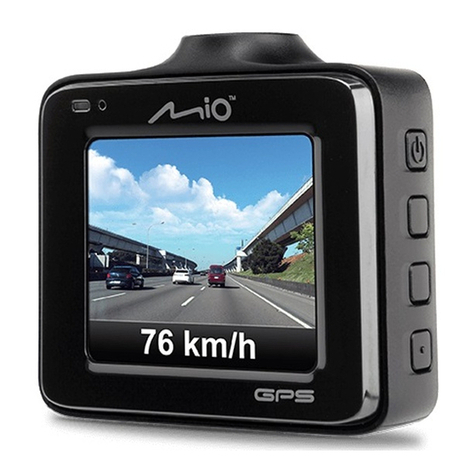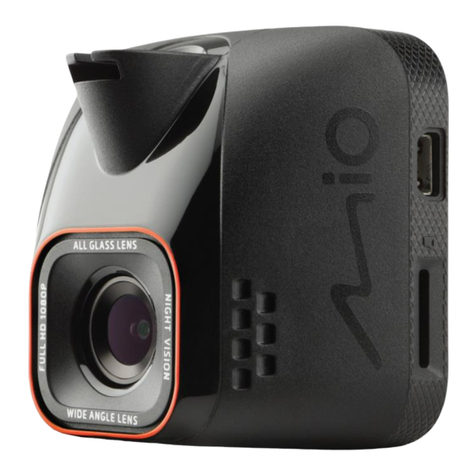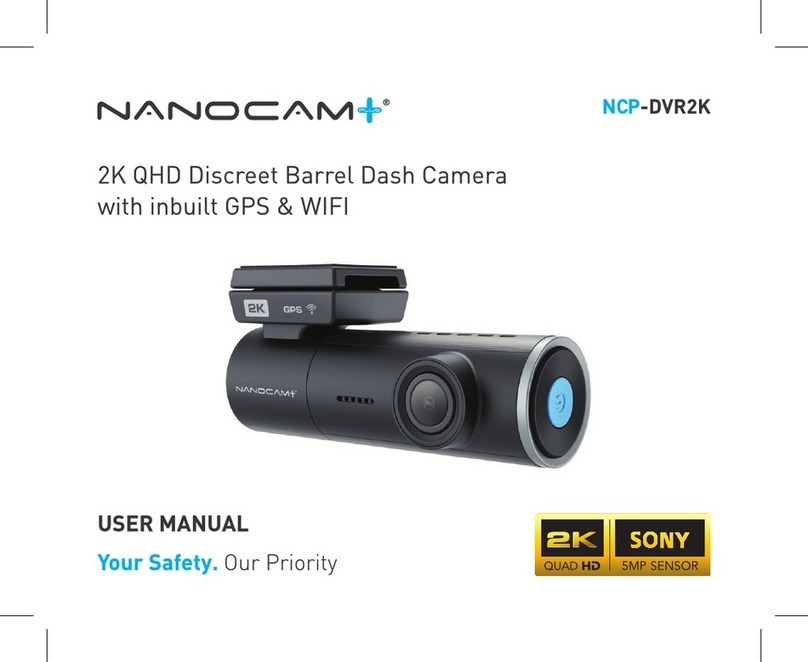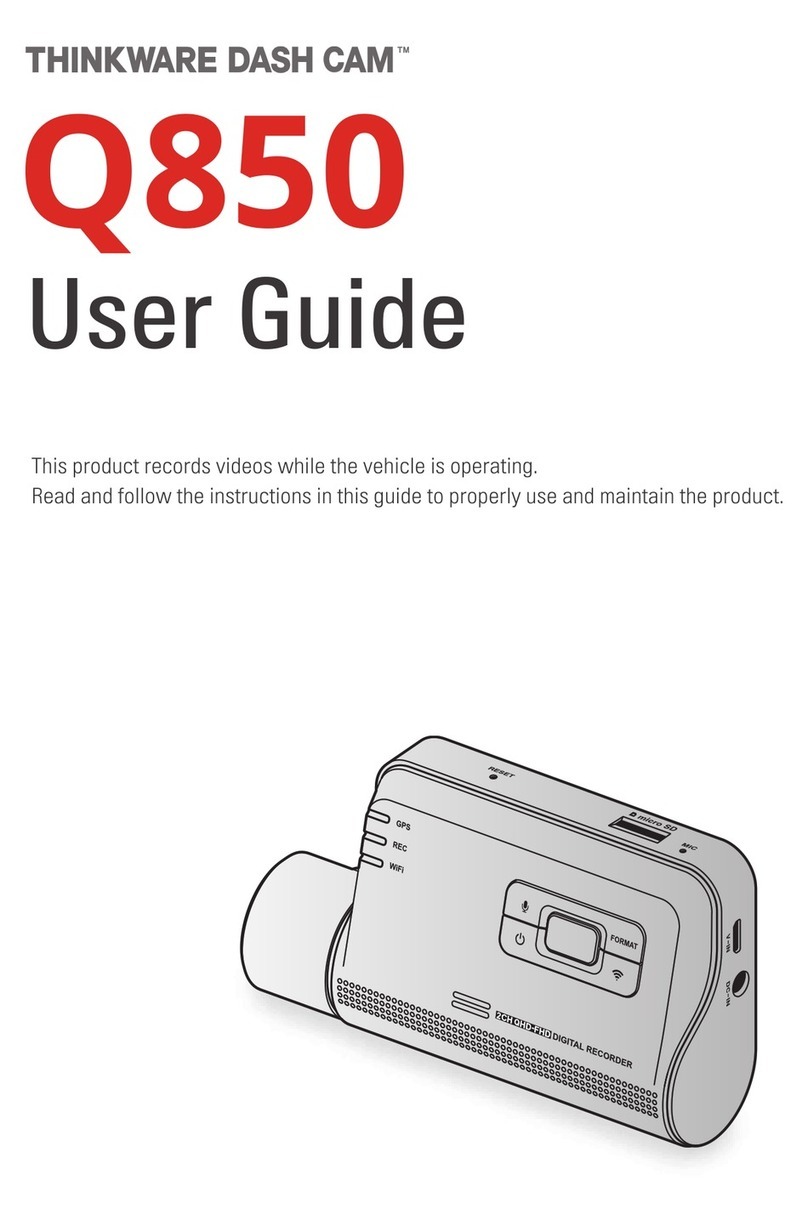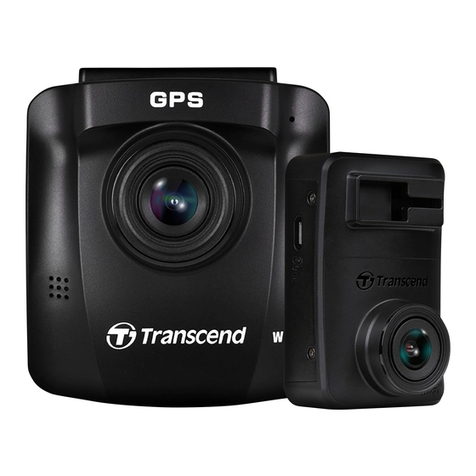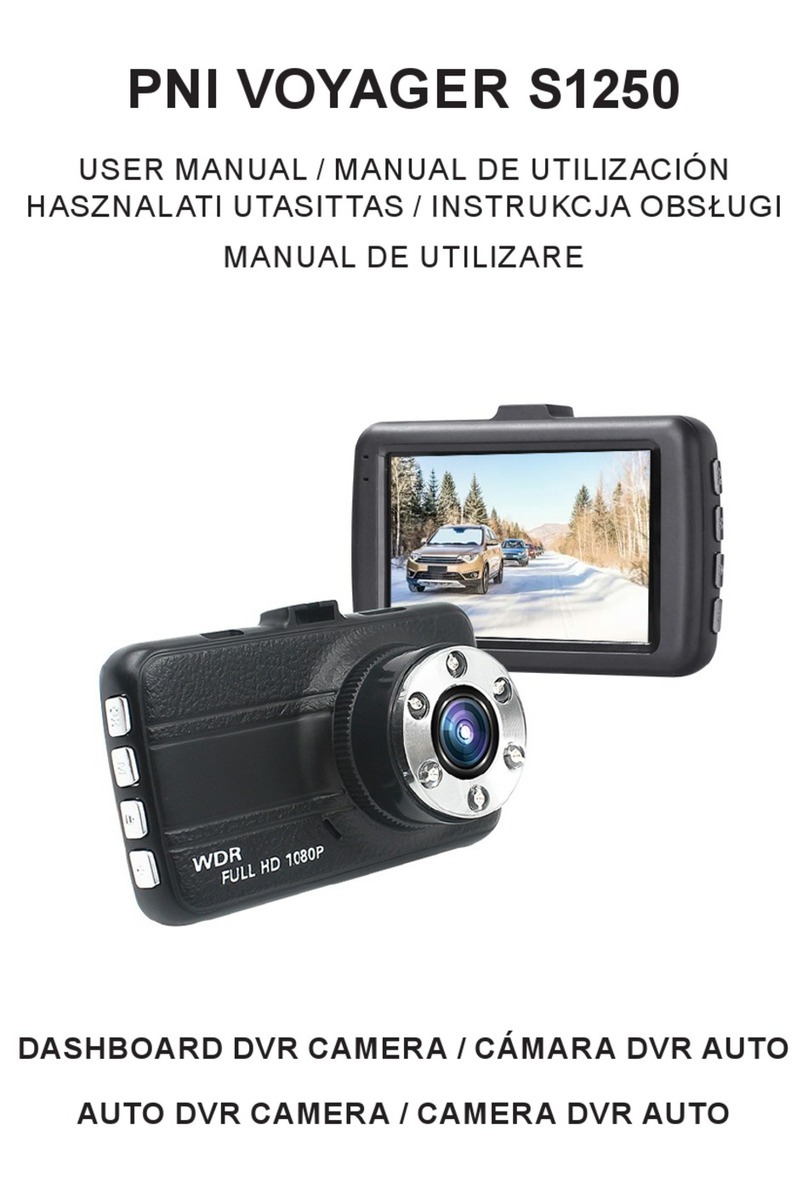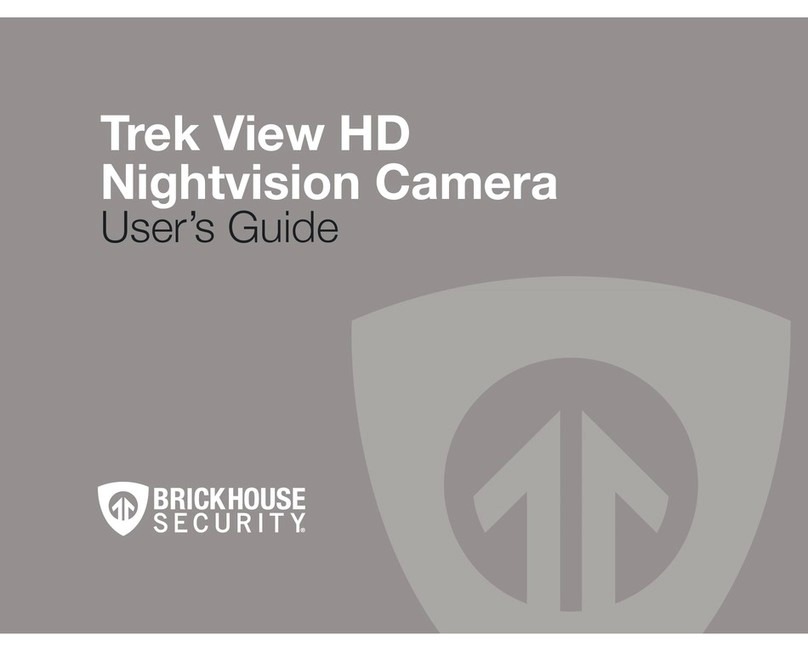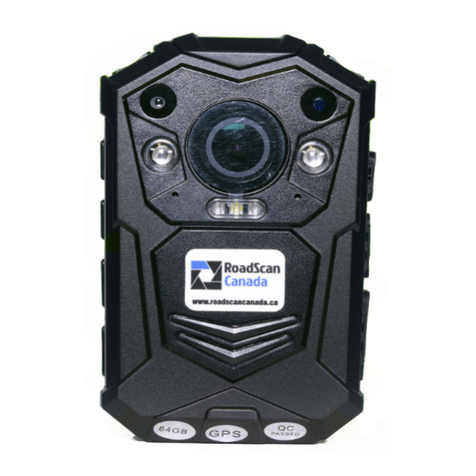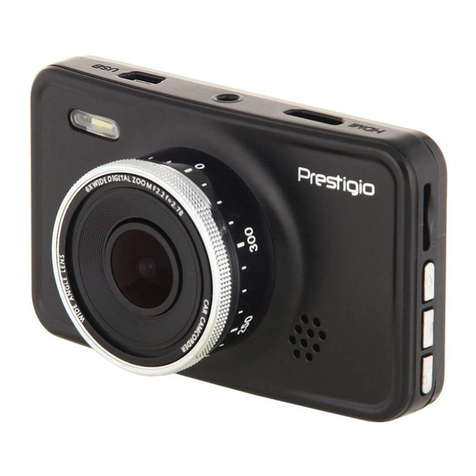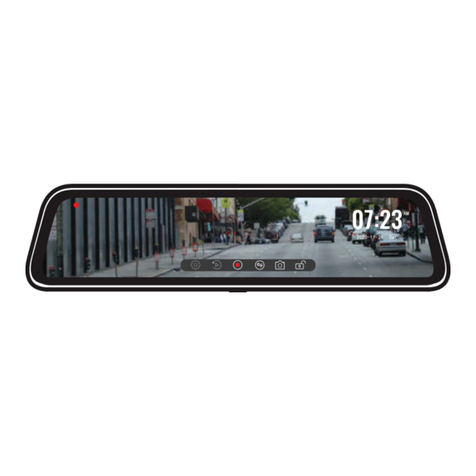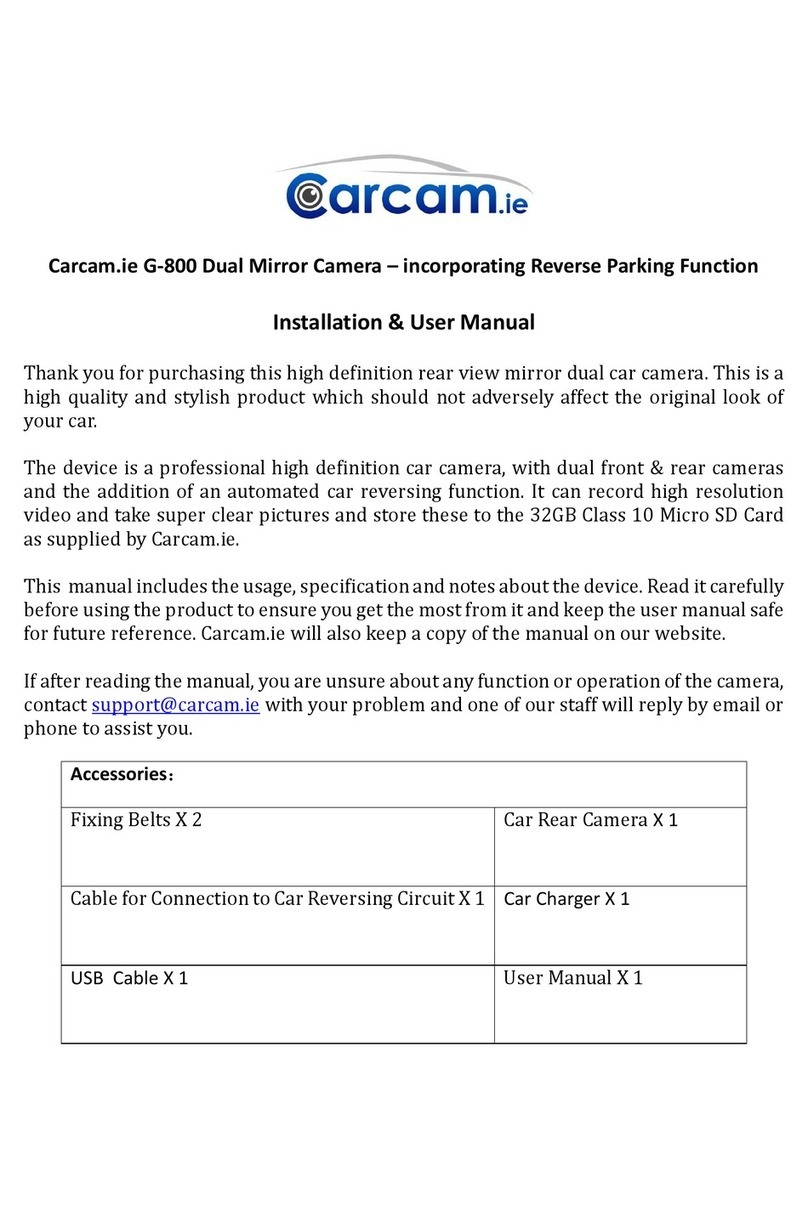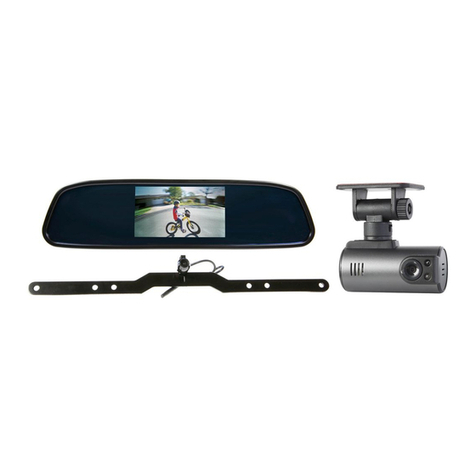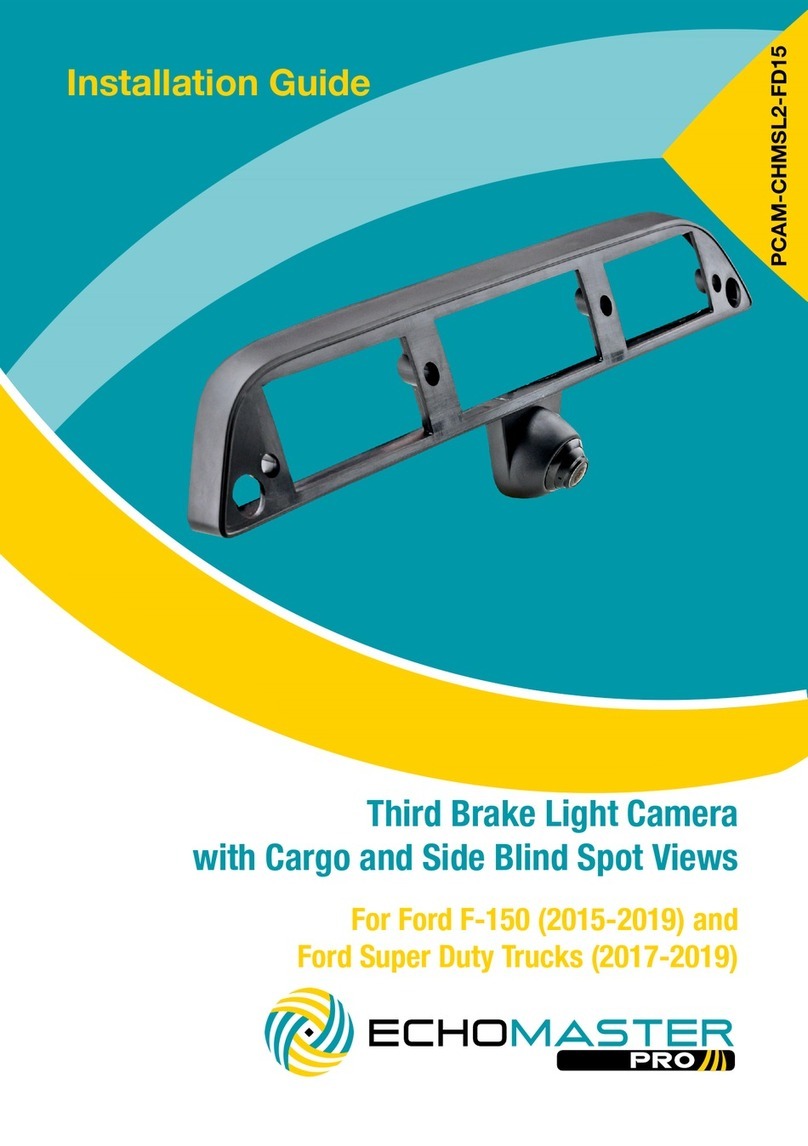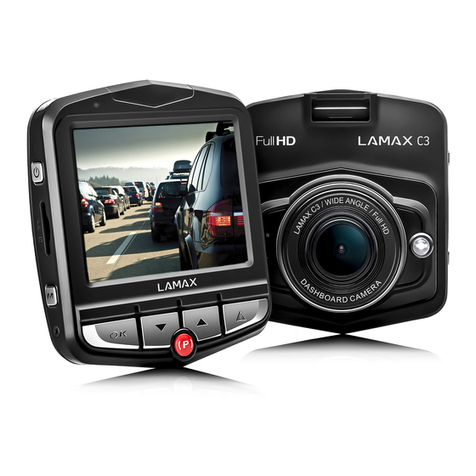Mio MiVue 388 User manual

English 3
Deutsch 11
Español 19
Français 27
Italiano 35
Nederlands 43

Revision: R00
(4/2013)
Trademarks
All brand and product names are trademarks or registered trademarks of their
respective companies.
Disclaimer
Specifications and documents are subject to change without notice. Mio Technology
does not warrant this document is error-free. Mio Technology assumes no liability
for damage incurred directly or indirectly from errors, omissions, or discrepancies
between the device and the documents.
Notes
Not all models are available in all regions.
Depending upon the specific model purchased, the color and look of your device and
accessories may not exactly match the graphics shown in this document.

English 3
Welcome
Thank you for purchasing MiVue 388. This Quick Start Guide guides you through a
successful setup and familiarises you with the basic skills of using the recorder.
Precautions and notices
For your own safety, do not operate the controls of the product while driving.
A window mount is needed when using the recorder in a car. Make sure that you
place the recorder in an appropriate place, so as not to obstruct the driver’s view
or deployment of airbags.
Make sure that no object is blocking the camera lens and no reflective material
appears near the lens. Please keep the lens clean.
If the car’s windscreen is tinted with a coating, it may impact the recording
quality.
GPS is operated by the United States government, which is solely responsible for
the performance of GPS. Any change to the GPS system can affect the accuracy
of all GPS equipment.
GPS satellite signals cannot pass through solid materials (except glass). When
you are inside a tunnel or building, GPS positioning is not available. Signal
reception can be affected by situations such as bad weather or dense overhead
obstacles (e.g. trees, tunnels, viaducts and tall buildings).
The GPS positioning data is for reference only.

4 English
Getting to know the recorder
Device mount socket
Speaker Camera lens
Mini-USB connector
HD OUT connector
Status indicator
OK key*
Down key*
Power key
Memory card slot
Menu key*
Up key*
Microphone
* Key function may vary on different screens.

English 5
Inserting a memory card
CAUTION: Do not apply pressure to the centre of the memory card.
You have to insert a memory card before you can start recording.
The recorder supports MicroSD cards with up to 32GB capacity. You are advised to use
a Class 6 memory card with at least 8GB capacity.
Hold the card (MicroSD) by the edges and gently insert it into
the slot with the label facing the camera lens of your recorder.
To remove a card, gently push the top edge of the card inwards
to release it, and pull it out of the slot.
Note: Mio Technology does not guarantee the product’s compatibility with MicroSD
cards from all manufacturers.
Note: Before you start recording, please format the MicroSD card to avoid
malfunction caused by files not created by MiVue 388. You can format the card on
your computer or on MiVue 388 (pressing the Menu key and then select the
format feature).
Using your recorder in a vehicle
CAUTION:
Select an appropriate location for mounting the device in a vehicle. Never
place the device where the driver’s field of vision is blocked.
If the car’s windscreen is tinted with a reflective coating, it may be athermic
and impact the GPS reception. In this instance, please mount your device
where there is a “clear area.”
DO NOT insert or remove the memory card when operating the recorder.

6 English
1 2 3
3
1
2
4
3
2
1
5
6
Use cable clips to secure the power cord so that it does not interfere with driving. To
ensure the highest quality recordings, you are advised to place the recorder near the
rear view mirror.

English 7
To ensure the optimal recording angle, pay attention to the following:
1. Make sure that your car is parked on a level ground.
2. When adjusting the angle of mounting, make sure that the camera’s view is
parallel with the level ground, and the ground/sky ratio is close to 6/4.
Operating basics
CAUTION: DO NOT remove or insert the memory card while recording.
Connect the recorder to the car charger according to the installation instructions in
the previous “Using your recorder in a vehicle” section.
Turning the recorder ON and OFF
Once the vehicle engine is started, the recorder automatically turns on. By default,
the recording will start right after the recorder turns on.
When a GPS fix is established, the icon will show on the top-right corner of the
screen. The number of the vertical bars in the icon indicates the strength of the signal.
When the vehicle engine is turned off, the recorder automatically saves the recording.
By default, the recorder will turn off immediately.
To manually turn the recorder on and off, press and hold the Power key for 2
seconds.
Setting the date and time
To make sure of the correct date and time for your recordings, please check the date
and time settings before you begin recording.

8 English
1. Press the Menu key to access the Settings menu.
2. Select Date / Time and press the OK key.
3. Use the ▲ and ▼ keys to adjust the value and press the OK key.
4. Repeat Step 3 until all fields have been changed.
Recording in driving mode
Continuous recording
When you connect the car charger to the cigarette lighter in the car, the recorder will
start continuous recording automatically. The recording may be divided into several
video clips; recording will not stop between video clips.
The recorder automatically stops and saves the recording when the vehicle engine is
turned off. If you want to stop recording manually, press the ▼ key.
When recording is not in progress, you can manually start the continuous recording at
any time by pressing the OK key. To stop recording, press the ▼ key.
The continuous recordings can be found in the “Video” category for file playback.
Note: If continuous recording is ongoing but there is not enough space on your
memory card, new video clips will replace the old ones.
Event recording
By default, if an event happens, such as sudden impact, high-speed driving, an
overdone turn or an accidental crash, the G sensor will prompt the recorder to start
an event recording.
If you want to manually start an event recording while continuous recording is in
progress, press the OK key.
To stop recording, press the ▼ key.
The event recordings can be found in the “Emergency” category for file playback.

English 9
Camera mode
If the recording is in progress, press the ▼ key to stop recording. When ready, press
the ▼ key to take the photo.
Playback mode
1. Press the Menu key to access the Settings menu.
2. Select File Playback and press the OK key.
3. Select the desired type and press the OK key. The types include:
Video (continuous recordings)
Emergency (event recordings)
Photo
4. Select the desired file from the list and press the OK key.
Safety camera alerts
Note: The safety camera alerts function is not allowed to use in France, Germany and
Switzerland.
You can receive alerts to warn you about the locations of safety
cameras, which will enable you to monitor your speed through these
areas.
Press the ▲ ( ) key to display the detection range and status of
safety cameras. Press the ▲ ( ) key again to return to the previous
screen.
When a safety camera appears within the red-outlined area and is
positioned in the detectable direction (as illustrated), you will receive
alerts.

10 English
The screen will display the visual alert, and you will also receive audio warnings. When
the alert sound setting is set to Beep:
When your car approaches a safety camera, you will receive a normal beep alert.
When your car approaches a safety camera at a speed over the set threshold, you
will receive a persistent beep alert until your car speed is under the threshold.
When your car passes through a safety camera, you will be notified by a different
beep alert.
Note: Mio does not warrant that all types and locations of safety camera data are
available, as cameras may be removed, relocated or new cameras installed.

Deutsch 11
Willkommen
Wir bedanken uns bei Ihnen für den Kauf des MiVue 388. Diese Schnellstartanleitung
führt Sie durch die Konfiguration und macht Sie mit den Grundlagen der Bedienung
des Rekorders vertraut.
Vorsichtsmaßnahmen und Hinweise
Zu Ihrer eigenen Sicherheit dürfen Sie das Gerät nicht während des Fahrens
bedienen.
Für die Verwendung des Rekorders in einem Fahrzeug ist eine Scheibenhalterung
erforderlich. Sie müssen den Rekorder an einer geeigneten Stelle anbringen, an
der er nicht die Sicht des Fahrers oder die Entfaltung von Airbags behindert.
Achten Sie darauf, dass das Kameraobjektiv nicht verdeckt ist und sich keine
reflektierenden Materialien in der Nähe des Objektivs befinden. Halten Sie das
Objektiv sauber.
Ist die Windschutzscheibe des Fahrzeugs getönt, könnte dies die
Aufnahmequalität beeinträchtigen.
GPS wird von der Regierung der Vereinigten Staaten betrieben, die einizg für
die GPS-Leistung verantwortlich ist. Änderungen am GPS-System können die
Genauigkeit aller GPS-Geräte beeinträchtigen.
GPS-Satellitensignale durchdringen keine festen Materialien (außer Glas). In
einem Tunnel oder einem Gebäude ist GPS-Positionierung nicht verfügbar.
Der Signalempfang kann von Umständen wie schlechtes Wetter oder dichte,
oberirdische Behinderungen (z.B. Bäume und hohe Gebäude) beeinträchtigt
werden.
Die GPS-Positionierungsdaten sind nur Bezugswerte.

12 Deutsch
Die Komponenten des Rekorders
Gerätmontagesockel
Lautsprecher Kameraobjektiv
Mini-USB-Anschluss
HD OUT-Anschluss
Statusanzeige
OK-Taste*
Nach-unten-Taste*
Ein/Aus-Taste
Steckplatz für
Speicherkarte
Menütaste*
Nach-oben-Taste*
Mikrofon
* Die Funktion dieser Taste kann je nach Bildschirm unterschiedlich sein.

Deutsch 13
Einsetzen einer Speicherkarte
VORSICHT: Üben Sie keinen Druck auf die Mitte der Speicherkarte aus.
Sie müssen eine Speicherkarte einsetzen, bevor Sie mit dem Aufnehmen beginnen
können.
Der Rekorder unterstützt MicroSD-Karten mit einer Kapazität bis zu 32 GB. Es wird
empfohlen, eine Class 6-Speicherkarte mit einer Kapazität von mindestens 8 GB zu
verwenden.
Halten Sie die Karte (MicroSD) an ihren Kanten fest und stecken
Sie sie vorsichtig in den Steckplatz hinein, wobei ihr Etikett zum
Objektiv Ihres Mio-Geräts weist.
Um eine Karte zu entnehmen, drücken Sie die Oberkante der
Karte vorsichtig in den Steckplatz hinein, sodass sie sich löst, und ziehen Sie sie heraus.
Hinweis: Mio Technology gewährleistet nicht, dass das Produkt mit MicroSD-Karten
aller Hersteller kompatibel ist.
Hinweis: Formatieren Sie die MicroSD-Karte vor dem Aufnehmen, um Probleme
aufgrund von Dateien zu vermeiden, die nicht vom MiVue 388 erstellt wurden. Sie
können die Karte auf Ihrem Computer oder auf dem MiVue 388 formatieren (drücken
Sie die Taste Menü , und wählen Sie dann die Formatierfunktion).
Der Rekorder in einem Fahrzeug
Achten Sie zur Sicherstellung eines optimalen Aufnahmewinkels auf Folgendes:
1. Vergewissern Sie sich, dass Ihr Fahrzeug auf einem ebenen Untergrund abgestellt
ist.

14 Deutsch
2. Achten Sie beim Anpassen des Montagewinkels darauf, dass die Kamerasicht
parallel zum ebenen Untergrund verläuft und das Verhältnis Boden/Himmel
etwa 6/4 beträgt.
Befestigen Sie das Verbindungskabel mit Kabelklemmen, damit es beim Fahren nicht
behindert. Für eine optimale Aufnahmequalität wird empfohlen, den Rekorder in der
Nähe des Rückspiegels anzubringen.
VORSICHT:
Wählen Sie eine geeignete Stelle für die Befestigung des Geräts in einem
Fahrzeug. Platzieren Sie das Gerät nie dort, wo das Sichtfeld des Fahrers
blockiert wird.
Falls die Windschutzscheibe mit einer reflektierenden Beschichtung getönt ist,
kann diese – wenn sie nicht thermisch ist – den GPS-Empfang beeinflussen. In
solch einem Fall montieren Sie Ihren Mio bitte an einer „durchsichtigen“ Stelle
– üblicherweise unterhalb des Rückspiegels.
Während der Bedienung des Rekorders dürfen Sie die Speicherkarte NICHT
einsetzen oder entnehmen.
1 2 3
3
1
2

Deutsch 15
4
3
2
1
5
6
Bedienungsgrundlagen
VORSICHT: Sie dürfen die Speicherkarte während der Aufnahmen NICHT
herausnehmen oder einsetzen.
Schließen Sie den Rekorder gemäß den Anweisungen im vorherigen Abschnitt
„Der Rekorder in einem Fahrzeug“ an das Ladegerät im Fahrzeug an.
Ein- und Ausschalten des Rekorders
Sobald der Fahrzeugmotor gestartet wird, schaltet sich der Rekorder automatisch ein.
Die Aufnahme beginnt standardmäßig gleich nach dem Einschalten des Rekorders.
Ist ein GPS-Fixpunkt ermittelt, blendet sich das Symbol oben rechts im

16 Deutsch
Bildschirm ein. Die Anzahl der vertikalen Balken im Symbol weist die Signalstärke aus.
Wenn der Fahrzeugmotor abgeschaltet wird, speichert der Rekorder automatisch die
Aufnahme. Der Rekorder schaltet sich standardmäßig sofort aus.
Zum manuellen Ein-und Ausschalten des Rekorders halten Sie die Ein/Aus-Taste 2
Sekunden lang gedrückt.
Einstellung des Datums und der Uhrzeit
Damit das Datum und die Uhrzeit Ihrer Aufnahmen richtig ist, prüfen Sie vor der
Aufnahme die Einstellung des Datums und der Uhrzeit.
1. Drücken Sie die Taste Menü , um das Menü Einstellungen aufzurufen.
2. Wählen Sie Datum / Zeit und drücken Sie OK.
3. Stellen Sie den Wert mit den Tasten ▲ und ▼ ein und drücken Sie OK.
4. Wiederholen Sie Schritt 3, bis alle Felder geändert sind.
Aufnehmen im Fahrmodus
Kontinuierliche Aufnahme
Wenn Sie das Ladegerät mit dem Zigarettenanzünder des Fahrzeugs verbinden, startet
der Rekorder automatisch im kontinuierlichen Aufnahmemodus. Die Aufnahme kann
in mehrere Videoclips unterteilt werden; die Aufnahme stoppt nicht zwischen den
Videoclips.
Wenn der Fahrzeugmotor abgeschaltet wird, stoppt der Rekorder automatisch und
speichert die Aufnahme. Wenn Sie die Aufnahme manuell stoppen möchten, drücken
Sie die Taste ▼.
Wird gerade nichts aufgenommen, können Sie den kontinuierlichen Aufnahmemodus
jederzeit durch Drücken der OK-Taste manuell starten. Zum Stoppen der Aufnahme
drücken Sie die Taste ▼.

Deutsch 17
Den kontinuierlichen Aufnahmemodus finden Sie in der „Video”-Kategorie bei
Dateiwiedergabe.
Hinweis: Dauert die kontinuierliche Aufnahme an, doch der Platz auf Ihrer
Speicherkarte reicht nicht mehr aus, werden Videoclips überschrieben.
Eventaufnahme
Bei einem Zwischenfall, z. B. einem plötzlichen Schaden, Fahren mit hoher
Geschwindigkeit, einer verpassten Kreuzung oder ein Unfall, veranlasst der G-Sensor
den Rekorder standardmäßig zu einer Aufnahme im „Notfall“ (einer Eventaufnahme).
Möchten Sie während einer laufenden Aufnahme eine Aufnahme im „Notfall“ manuell
starten, drücken Sie OK.
Zum Stoppen der Aufnahme drücken Sie die Taste ▼.
Eventaufnahmen finden Sie in der „Notfall”-Kategorie bei Dateiwiedergabe.
Kameramodus
Wenn die Aufnahme läuft, drücken Sie die Taste ▼, um die Aufnahme zu stoppen.
Drücken Sie die Taste ▼, wenn Sie bereit sind, ein Foto zu machen.
Wiedergabemodus
So wählen Sie ein Video oder Foto für die Wiedergabe aus:
1. Drücken Sie die Taste Menü , um das Menü Einstellungen aufzurufen.
2. Wählen Sie Dateiwiedergabe und drücken Sie OK.
3. Wählen Sie den gewünschten Typ und drücken Sie OK. Es gibt folgende Typen:
Video (kontinuierliche Aufnahmen)
Notfall (Eventaufnahmen)
Foto

18 Deutsch
4. Wählen Sie die gewünschte Datei aus der Liste aus und drücken Sie OK.
Warnung vor Radarkameras
Hinweis: Der Einsatz von Warnung vor Radarkameras ist in Frankreich, Deutschland
und der Schweiz nicht erlaubt.
Sie können vor den Standorten von Radarkameras gewarnt werden, sodass Sie Ihre
Geschwindigkeit in den betroffenen Abschnitten überwachen können.
Drücken Sie die Taste ▲ ( ) um den Erfassungsbereich und den
Status der Radarkameras anzuzeigen. Durch erneutes Drücken der
Taste ▲ ( ) kehren Sie zum vorherigen Bildschirm zurück.
Erscheint eine Radarkamera innerhalb des rot umrandeten Bereichs
und befindet sie sich in Erkennungsrichtung (wie abgebildet), werden
Sie gewarnt.
Neben hörbaren Warnsignalen erhalten Sie auf dem Bildschirm auch
einen visuellen Alarm. Ist der Warnton auf Signalton gesetzt:
Nähert sich Ihr Fahrzeug einer Radarkamera, wird ein normaler Signalton zur
Warnung ausgegeben.
Nähert sich Ihr Fahrzeug einer Radarkamera mit einer Geschwindigkeit, die ber
dem eingestellten Tempolimit liegt, wird so lange ein durchgehender Signalton
zur Warnung ausgegeben, bis Ihr Fahrzeug sich wieder unter dem Tempolimit
befindet.
Passiert Ihr Fahrzeug eine Radarkamera, werden Sie mit einem anderen Signalton
benachrichtigt.
Hinweis: Mio garantiert nicht, dass alle Daten zu Typen und Standorten von
Radarkameras verfügbar sind, denn Kameras können entfernt und an anderer Stelle
aufgebaut werden, oder es können neue Kameras installiert worden sein.

Español 19
Bienvenido
Gracias por adquirir MiVue 388. Esta Guía de inicio rápido le guiará a través del
proceso de instalación de su dispositivo y le ayudará a familiarizarse con las funciones
básicas de la grabadora.
Precauciones y avisos
Por su propia seguridad, no intente manipular los controles del producto
mientras conduce.
Para instalarlo en el coche, necesitará un soporte de ventana. Asegúrese
de colocar la grabadora en un lugar apropiado para no obstruir la visión del
conductor o el despliegue de los airbags.
Asegúrese de que ningún objeto bloquee la lente de la cámara y de que no haya
ningún material reflector junto a la lente. Mantenga la lente limpia.
El uso en vehículos con cristales tintados puede afectar a la calidad de la
grabación.
El GPS es operado por el gobierno de los Estados Unidos, que es el único
responsable del rendimiento del GPS. Cualquier cambio en el sistema GPS puede
afectar a la precisión del equipo GPS.
Las señales de satélite GPS no pueden pasar a través de materiales sólidos
(excepto el cristal). La recepción de la señal puede verse afectada por situaciones
como el mal tiempo u obstáculos de gran tamaño (como árboles o edificios
altos).
Los datos de posicionamiento del GPS son únicamente orientativos.

20 Español
Introducción a la grabadora
Ranura de sujeción del
dispositivo
Altavoz Lente de la cámara
Conector mini-USB
Conector HD OUT
Indicador de estado
Tecla OK*
Tecla Abajo*
Tecla de encendido
Ranura de tarjeta de
memoria
Tecla Menú*
Tecla Arriba*
Micrófono
* Esta función de tecla puede variar en función de cada escena.
Other manuals for MiVue 388
1
Table of contents
Languages:
Other Mio Dashcam manuals
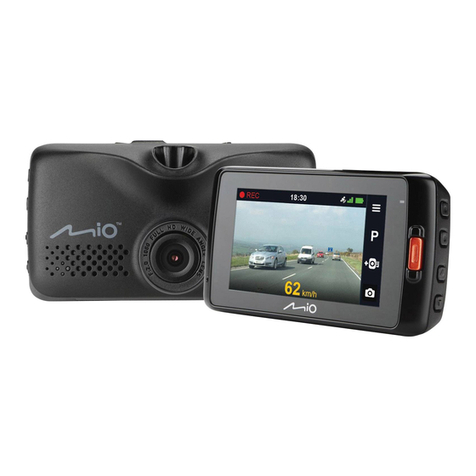
Mio
Mio MIVUE 618 User manual
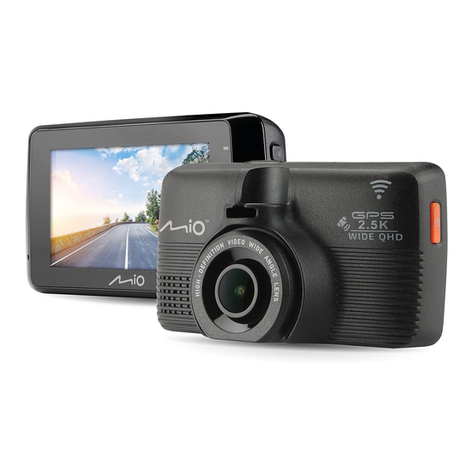
Mio
Mio MiVue 798 User manual
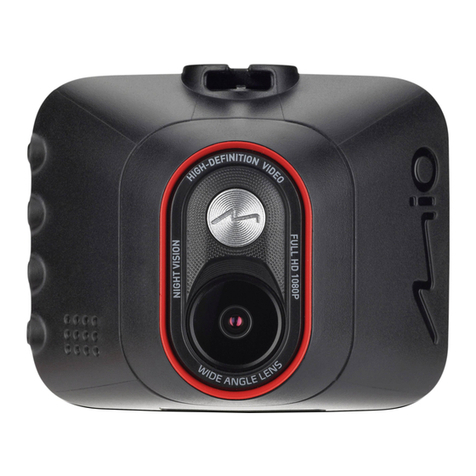
Mio
Mio MiVue C312 User manual
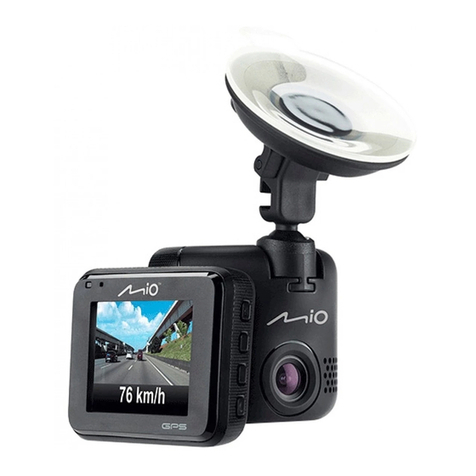
Mio
Mio MiVue C320 Series User manual
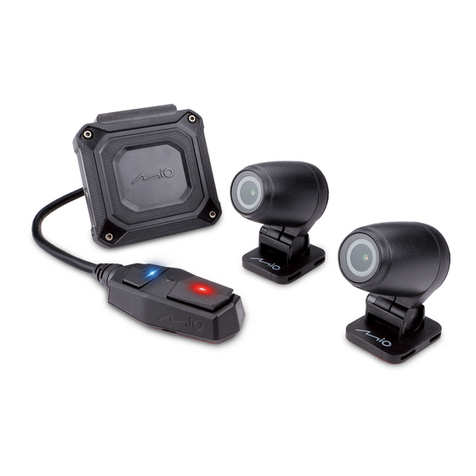
Mio
Mio MiVue M760D User manual
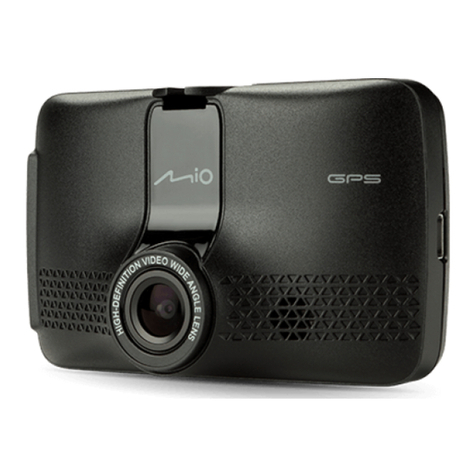
Mio
Mio MiVue 730 Series User manual
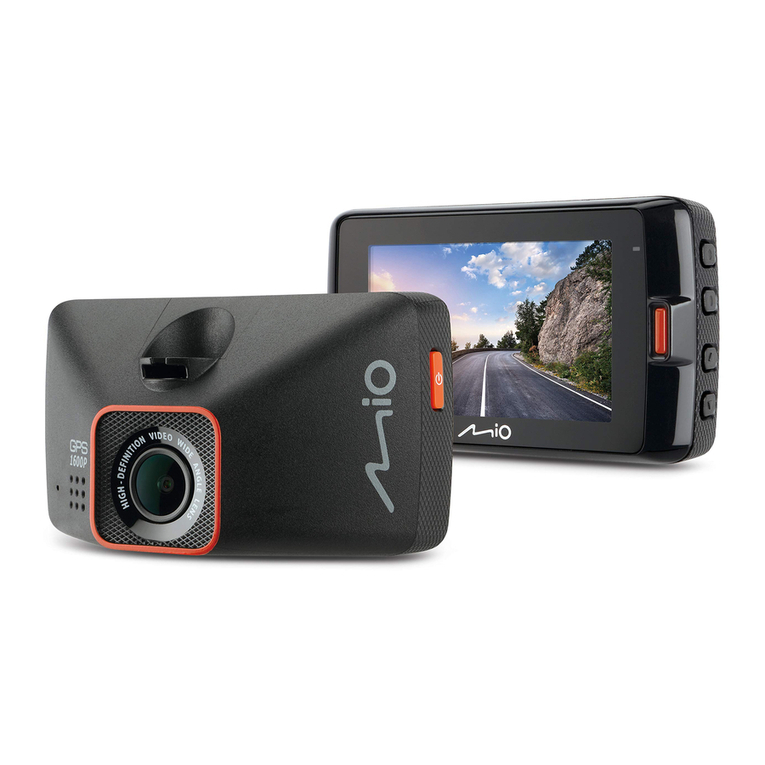
Mio
Mio MiVue 795 Series User manual
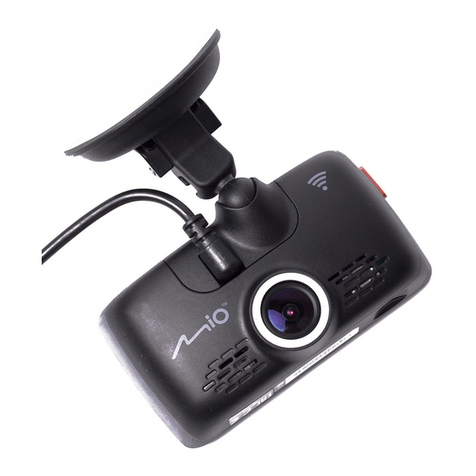
Mio
Mio MiVue 6 series User manual

Mio
Mio MiVue 730 Series User manual
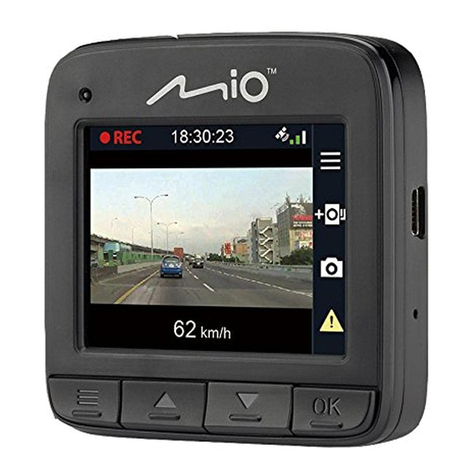
Mio
Mio MiVue C310 User manual
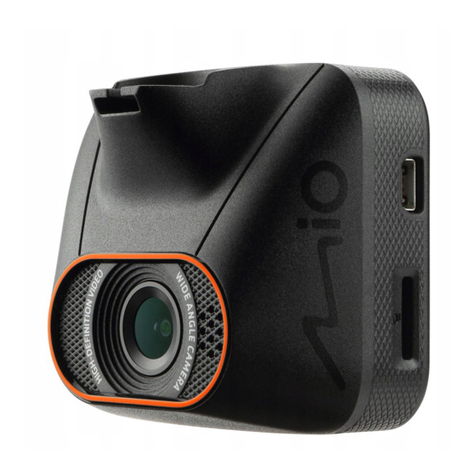
Mio
Mio MiVue C540 Series User manual

Mio
Mio MiVue M760D User manual

Mio
Mio MiVue 795 Series User manual
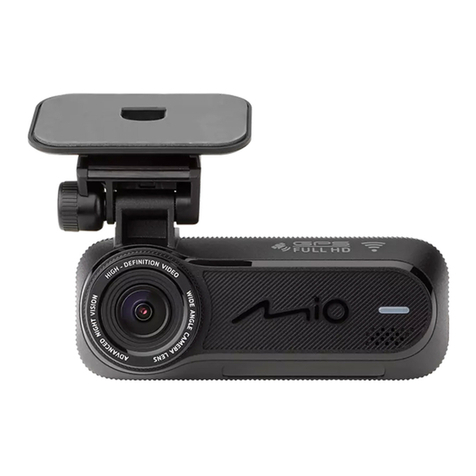
Mio
Mio MiVue J60 Series User manual
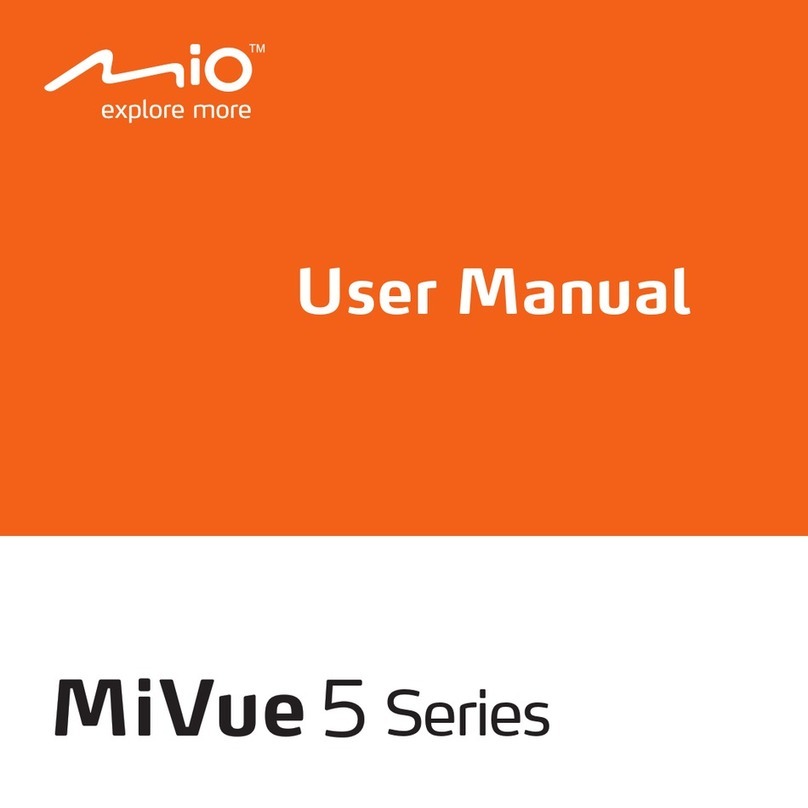
Mio
Mio MiVue 5 series User manual
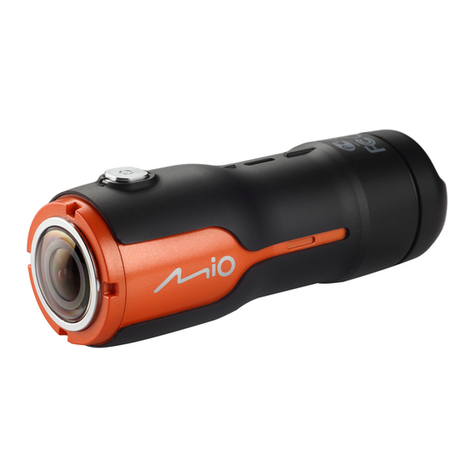
Mio
Mio MiVue M350 User manual

Mio
Mio MiVue C312 User manual
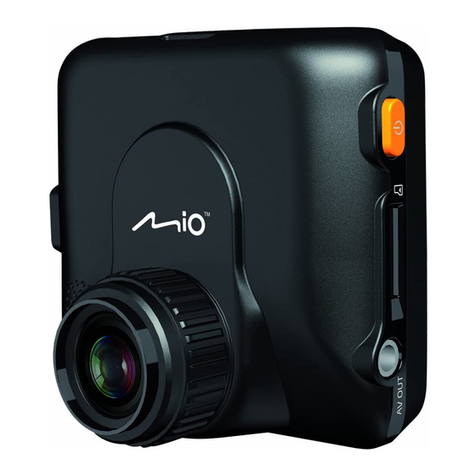
Mio
Mio MiVue 338 User manual

Mio
Mio MiVue 338 User manual
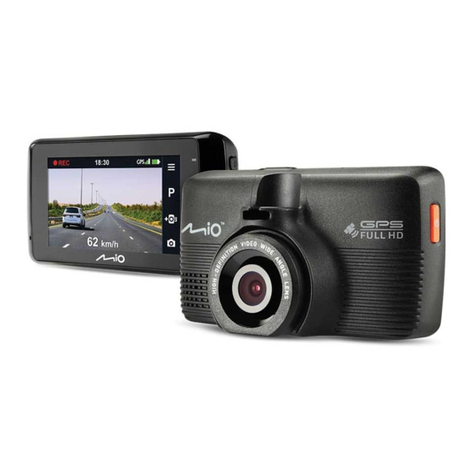
Mio
Mio MiVue 790 series User manual

